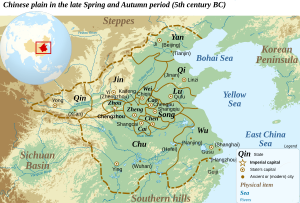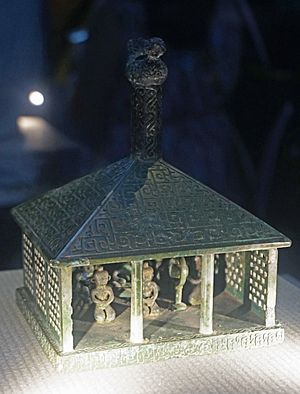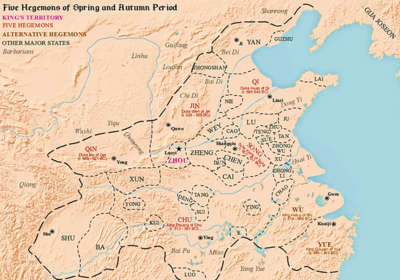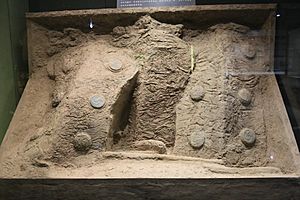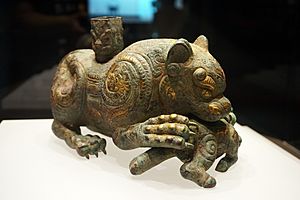Spring and Autumn period facts for kids
Quick facts for kids Spring and Autumn period |
|||||||||||||||||||||||||||||||||||||
|---|---|---|---|---|---|---|---|---|---|---|---|---|---|---|---|---|---|---|---|---|---|---|---|---|---|---|---|---|---|---|---|---|---|---|---|---|---|
| Traditional Chinese | 春秋時代 | ||||||||||||||||||||||||||||||||||||
| Simplified Chinese | 春秋时代 | ||||||||||||||||||||||||||||||||||||
| Hanyu Pinyin | Chūn-Qiū Shídài | ||||||||||||||||||||||||||||||||||||
|
|||||||||||||||||||||||||||||||||||||
The Spring and Autumn period was an important time in Chinese history. It lasted from about 770 BCE to 481 BCE. This period is the first half of the Eastern Zhou dynasty. Its name comes from a famous book called the Spring and Autumn Annals. This book recorded events in the state of Lu between 722 and 481 BCE. Many people believe the wise teacher Confucius (551–479 BCE) was involved with this book.
During this time, the power of the king slowly faded away. Local lords became more independent. They made their own deals, fought their own wars, and even challenged the king's court. The end of this period is usually marked by the breakup of one of the strongest states, Jin. This event led to the start of the Warring States period.
Contents
Why the Spring and Autumn Period Began

In 771 BCE, a group called the Quanrong attacked the capital city of the Western Zhou dynasty. They teamed up with the states of Zeng and Shen. The attack destroyed the capital, Haojing, and killed King You. A new king, Yijiu, was then placed on the throne in a new eastern capital, Luoyi. This event started the Eastern Zhou dynasty.
During the Spring and Autumn period, the old system of `fengjian` (封建) became less important. This system was like a feudal system where the king gave land to his relatives and generals. In return, they were supposed to support him. But the Zhou court lost its power. The king only controlled a small area around Luoyi. The lords of the different areas became very independent. They turned their lands into powerful states.
The most important states often met to discuss big issues. These included military trips against outside groups or against nobles who caused trouble. Sometimes, one powerful ruler was chosen as the `hegemon` (Chinese: 伯; pinyin: bó). This leader was the strongest and guided the other states.
As time went on, bigger states took over smaller ones. By the 6th century BCE, most small states were gone. Only a few large and strong states ruled China. Some southern states, like Chu and Wu, even said they were completely independent from the Zhou king. This led to wars.
There were also many fights within the states themselves. For example, six powerful families fought each other in Jin. Political enemies tried to get rid of the Chen family in Qi. Rulers were often challenged by their own family members in Qin and Chu. Once these rulers became strong in their own lands, the fighting mostly shifted to wars between the states. This led to the Warring States period, which began in 403 BCE.
Early Years of the Spring and Autumn Period (771–685 BCE)
The King Moves East (771 BCE)
After the old capital was destroyed, the Zhou king moved his capital east. The new capital was called Wangcheng, located in the Yellow River Valley. The king was now closer to his main supporters, like Jin and Zheng. But the king's power was much weaker. He had to rely on these powerful states for protection. The Zhou court never got its full power back. It became more of a symbol, a leader for ceremonies. Even though the king still had the `Mandate of Heaven` (the idea that he was chosen by the gods), he had little real power.
With the king's power gone, the Yellow River area was split into hundreds of small, independent states. Most were just one city. But a few, especially those on the edges, grew very strong. Records mention 148 states during this time. By the end of the period, 128 of them had been taken over by the four largest states.
Soon after the king moved east, a system of alliances began. The Zhou king would give the title of `hegemon` (Chinese: 霸) to the state with the strongest army. The hegemon's job was to protect the weaker Zhou states and the king from outside groups. This system helped keep some order. But fighting between and within states often made people care less about old traditions and respect for the king. The king's prestige helped the military leaders gain power. It also helped them organize defenses against "barbarians."
Over the next two centuries, four very powerful states fought for control: Qin, Jin, Qi, and Chu. These large states often used the excuse of "helping" smaller states to take them over. During this time of fast growth, states either fought small wars or used complex diplomacy.
Zheng Challenges the King (722–685 BCE)
In 722 BCE, Duke Yin of Lu became ruler. From this year on, the state of Lu kept an official record called the Spring and Autumn Annals. This book is our main source of information for this period. Other states also had similar records, but they are now lost.
In 717 BCE, Duke Zhuang of Zheng visited the king. The duke felt he was not treated with enough respect. Zheng was now the main protector of the capital. Later, in 715 BCE, Zheng also had a land dispute with Lu. This was seen as an insult to the king.
By 707 BCE, relations were so bad that the king sent an army to punish Zheng. But Duke Zhuang fought back. He attacked the king's land and defeated the royal army in the Battle of Xuge. The king himself was even injured. Zheng was the first state to openly challenge the king. This started centuries of warfare where old traditions were no longer respected.
Zheng's military strength was clear. But after Duke Zhuang died in 701 BCE, problems with who would rule next weakened the state.
The Five Hegemons (685–591 BCE)
Qi Becomes the First Hegemon (685–643 BCE)
The first powerful leader to be called `hegemon` was Duke Huan of Qi (ruled 685–643 BCE). With the help of his chief minister, Guan Zhong, Duke Huan made Qi stronger. He changed how the state was run, making it more centralized. This allowed Qi to gather resources better than other states. Qi was already rich from controlling trade routes.
By 667 BCE, Qi was clearly the strongest in terms of money and military. Duke Huan gathered the leaders of Lu, Song, Chen, and Zheng. They chose him as their leader. Soon after, King Hui of Zhou gave Duke Huan the title of `bà` (hegemon). This gave him royal power in military actions. Qi's main reason for leading was the slogan 'Revere the King, Expel the Barbarians'. This meant respecting the Zhou king and driving out non-Chinese groups. Later hegemons also used this idea to justify their power. Duke Huan used his power to help Lu, protect Yan from nomads, and drive out northern nomads from Wey and Xing. He also led an alliance of eight states to conquer Cai, stopping Chu from expanding north.
When Duke Huan died in 643 BCE, five of his sons fought for the throne. This greatly weakened Qi. For almost ten years, no ruler held the title of hegemon.
Song Tries to Be Hegemon (643–637 BCE)
Duke Xiang of Song tried to become the next hegemon after Qi weakened. He wanted to bring back the old Shang dynasty, from which Song was descended. He held peace meetings and fought aggressively against his rivals. But Duke Xiang's plans ended when he attacked the much larger state of Chu. Song's army was defeated in the Battle of Hong in 638 BCE. The duke himself died the next year from injuries. After his death, Song became less ambitious.
Duke Xiang was never officially recognized as hegemon by the Zhou King. So, some historians do not list him as one of the Five Hegemons.
Jin Becomes Hegemon (636–628 BCE)
Duke Wen of Jin became ruler in 636 BCE. He built on the changes made by his father, Duke Xian. His father had made Jin stronger by taking over sixteen smaller states. He also brought in some non-Chinese groups. When Duke Wen helped King Xiang in a fight over who would be king in 635 BCE, the king gave Jin valuable land.
Duke Wen then used his growing power to work with Qi, Qin, and Song against Chu. Chu had been expanding north after Duke Huan of Qi died. Jin defeated Chu in the Battle of Chengpu in 632 BCE. King Xiang then rewarded Duke Wen by giving him the title of `bà`.
After Duke Wen died in 628 BCE, fighting between states grew. Smaller states, especially those between Jin and Chu, became constant battlegrounds. Qi and Qin also fought with Jin or its allies to gain more power.
Qin's Influence (628–621 BCE)
Duke Mu of Qin became ruler in 659 BCE. He made an alliance with Jin by marrying his daughter to Duke Wen. In 624 BCE, he gained control over the western `Rong barbarians`. He became the most powerful lord in the west. However, he did not lead alliances with other states. He was also not officially recognized as hegemon by the king. Because of this, not all historians count him as one of the Five Hegemons.
Chu's Rise to Power (613–591 BCE)
King Zhuang of Chu expanded Chu's borders far north of the Yangtze River. This threatened the central states. At one point, Chu's army reached just outside the royal capital. King Zhuang even sent a messenger to ask about the weight of the Nine Tripod Cauldrons. These cauldrons were symbols of the king's power. This hinted that he might move them to his own capital. In the end, the Zhou capital was safe. Chu then focused on attacking the nearby state of Zheng. Jin tried to save Zheng but was defeated by Chu. This showed that Chu was now the strongest state.
Even though he was very powerful, King Zhuang's title of "king" was never accepted by the Zhou states. In the Spring and Autumn Annals, he is called `Zi` (Chinese: 子, ruler; unratified lord). But later historians always include him as one of the Five Hegemons.
Later Spring and Autumn Period (591–453 BCE)
The Six Ministers (588 BCE)
Besides fighting between states, there were also fights within states. These were between the rulers and powerful noble families. Eventually, the dukes of Lu, Jin, Zheng, Wey, and Qi became mere figureheads. The real power was held by strong aristocratic families.
In Jin, this change happened in 588 BCE. The army was split into six independent parts. Each part was controlled by a different noble family. The heads of these six families were given titles and became ministers. They led the six main government departments. From this point on, historians call them "The Six Ministers." They were the true rulers of Jin.
The same thing happened in Lu in 562 BCE. The Three Huan families divided the army and created their own areas of influence. The heads of these three families were always important government leaders in Lu.
The Rise of Wu (584 BCE)
Wu was a state in modern Jiangsu. It was outside the main Zhou culture. Its people were seen as "barbarians" because they had short hair and tattoos. They also spoke a different language. Even though their ruling family claimed to be related to the Zhou, Wu did not join in Chinese politics and wars until later in the Spring and Autumn period.
Their first recorded interaction with the Chinese states was in 584 BCE. A Wu army attacked the small state of Tan. This caused alarm in the Chinese courts. Jin quickly sent an ambassador to the Wu king, Shoumeng. Jin promised to give Wu modern military technology and training. In return, Wu would ally with Jin against Chu. Chu was Wu's neighbor and Jin's enemy. King Shoumeng accepted. Wu continued to bother Chu for many years.
Attempts at Peace (579 BCE)
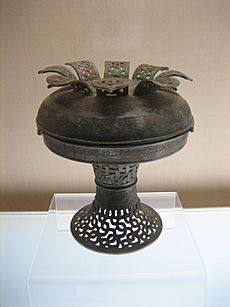
After a long period of tiring wars, Qi, Qin, Jin, and Chu met in 579 BCE. They held a meeting to reduce their armies and agreed to a truce. This peace did not last long. It became clear that the `bà` (hegemon) role was no longer needed. The four major states had their own areas of control. The idea of protecting Zhou land was less important. Non-Zhou peoples were now part of the culture. Chu also controlled some Zhou areas. This made the difference between Zhou and non-Zhou less clear.
New noble families were also formed. They were loyal to powerful states, not directly to the Zhou kings. This process slowed down by the end of the 7th century BCE. This was probably because there was no more land to expand into. The Zhou kings had also lost much of their respect. So, when Duke Dao of Jin (ruled 572–558 BCE) was recognized as `bà`, it meant much less than before.
Wu Becomes Hegemon (506–496 BCE)
In 506 BCE, King Helü became the ruler of Wu. With the help of Wu Zixu and Sun Tzu (who wrote The Art of War), he launched major attacks against Chu. They won five battles and conquered Chu's capital, Ying. However, Chu asked Qin for help. After being defeated by Qin, Helü's younger brother, Fugai, led a rebellion. Helü had to leave Chu. King Helü died during an invasion of Yue in 496 BCE. Some historians list him as one of the Five Hegemons.
His son, King Fuchai of Wu, took over. He almost destroyed the Yue state, even imprisoning King Goujian of Yue. Fuchai then defeated Qi and expanded Wu's power into central China.
In 499 BCE, the famous philosopher Confucius became acting prime minister of Lu. People traditionally believe he wrote or edited the Spring and Autumn Annals. After only two years, he had to resign. He spent many years traveling between different states before returning to Lu. He did not go back into politics. Instead, he preferred to teach. It is said that during this time, he edited or wrote the Five Classics.
Yue Becomes Hegemon (496–465 BCE)
In 482 BCE, King Fuchai of Wu held a meeting to strengthen his power. But Yue captured the Wu capital. Fuchai rushed back but was trapped and died when the city fell in 473 BCE. Yue then focused on weaker neighboring states. With help from Chu, Yue's enemy, Yue won after many years of fighting. King Goujian destroyed and took over Wu in 473 BCE. After this, he was recognized as hegemon.
Historians don't have much information about King Goujian's rule after this. He ruled until his death. His descendants ruled for six more generations. Then, the state of Yue was taken over by Chu during the Warring States period.
The Breakup of Jin
After Jin's powerful era, its rulers started to lose control over their noble families. A big civil war from 497 to 453 BCE ended with most noble families being wiped out. The remaining noble families divided Jin into three new states: Han, Wei, and Zhao. This is the last event mentioned in the Zuozhuan (a famous historical text).
With most smaller states now gone, this breakup left seven major states in the Zhou world. These were the three parts of Jin, the three strong states of Qin, Chu, and Qi, and the weaker state of Yan near modern Beijing. The breakup of Jin, along with another event where the Tian family took over Qi, marks the beginning of the Warring States period.
How States Got Along
Old books like the Zuo Zhuan and Chunqiu tell us about how states interacted. This included rulers visiting each other's courts, officials meeting, friendly messages being sent, and even hunting parties.
Because Chu was not originally from the Zhou culture, it was seen as partly "barbarian." Its rulers even called themselves kings, starting with King Wu in 704 BCE. Chu tried to expand into Zhou territory many times. But other states stopped them in big battles like Chengpu (632 BCE), Bi (595 BCE), and Yanling (575 BCE). These battles helped bring back the states of Chen and Cai.
Important Writings
Some versions of the Five Classics existed during the Spring and Autumn period. People in books like the Zuozhuan and Analects often quote from the Book of Poetry and Book of Documents. The Zuozhuan even shows some characters writing poems that later became part of the Book of Poetry. The Analects often talks about "The Rites." This could mean the Etiquette and Ceremonial book or just the general idea of rituals. The Book of Changes was definitely around. Many characters in the Zuozhuan used it for telling the future and quoted from it accurately.
Sima Qian, a famous historian, said that Confucius edited the versions of the Book of Poetry, Book of Documents, and Book of Rites. He also said Confucius wrote comments for the Book of Changes and wrote all of the Spring and Autumn Annals. For a long time, this was the main belief in China. But modern scholars think it's unlikely that one person wrote all five classics.
Many thinkers like Lao Tzu and Sun Tzu were active during this period. But their ideas were probably not written down until the next period, the Warring States.
Important People
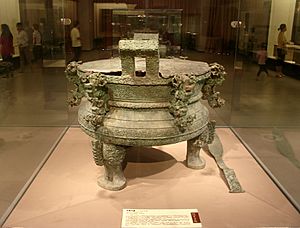
The Five Hegemons (春秋五霸): Since the Zhou royal family was weak, powerful lords took on the role of hegemon. Their job was to support the Zhou family and keep peace. They paid tribute to the king and received tribute from other rulers. Traditional history lists five hegemons:
- Duke Huan of Qi (ruled 685–643 BCE)
- Duke Xiang of Song (ruled 650–637 BCE)
- Duke Wen of Jin (ruled 636–628 BCE)
- Duke Mu of Qin (ruled 659–621 BCE)
- King Zhuang of Chu (ruled 613–591 BCE)
Some other lists of hegemons exist:
- Duke Huan of Qi (ruled 685–643 BCE)
- Duke Wen of Jin (ruled 636–628 BCE)
- King Zhuang of Chu (ruled 613–591 BCE)
- King Fuchai of Wu (ruled 495–473 BCE)
- King Goujian of Yue (ruled 496–465 BCE)
Important Officials and Advisors
- Guan Zhong: A key advisor to Duke Huan of Qi.
- Baili Xi: Prime minister of Qin.
- Wu Zixu: An important advisor to King Helü of Wu. He is sometimes called "the best recorded individual" from this period.
- Bo Pi: An official under King Helü who helped with relations between Wu and Yue.
- Wen Zhong: Advisor to King Goujian of Yue in his war against Wu.
- Fan Li: Another advisor to Goujian, also known for his business skills.
- Zichan: A leader in Zheng who worked to strengthen his state.
- Yan Ying (or Yanzi): A central figure in the Yanzi Chunqiu book.
Influential Thinkers
- Confucius (or Kongzi): A leading figure in Confucianism, a major philosophy.
- Lao-tse (or Laozi): A teacher of Taoism, another important philosophy.
- Mo Di (Mozi or Mo-tse): The founder of Mohism.
- Sun Tzu (or Sunzi): The author of The Art of War, a famous book on military strategy.
Other Notable People
- Lu Ban: A master builder and inventor.
- Yao Li: Sent by King Helü to kill Qing Ji.
- Zhuan Zhu: Sent by Helü to kill his cousin King Liao.
- Bo Ya: A very talented musician.
States of the Spring and Autumn Period
During the Eastern Zhou dynasty, there were many states. Records say there were 1773 states in total. We know the names of 148 of them. Over time, many smaller states were taken over by larger, more powerful ones. The map at the beginning of this article shows some of the most important states during this time.
Images for kids
See also
 In Spanish: Primaveras y otoños para niños
In Spanish: Primaveras y otoños para niños


